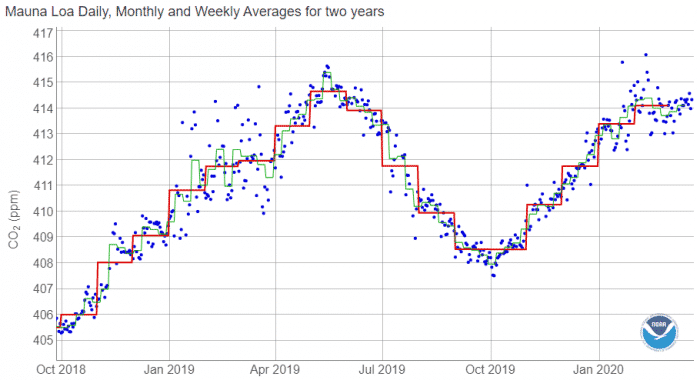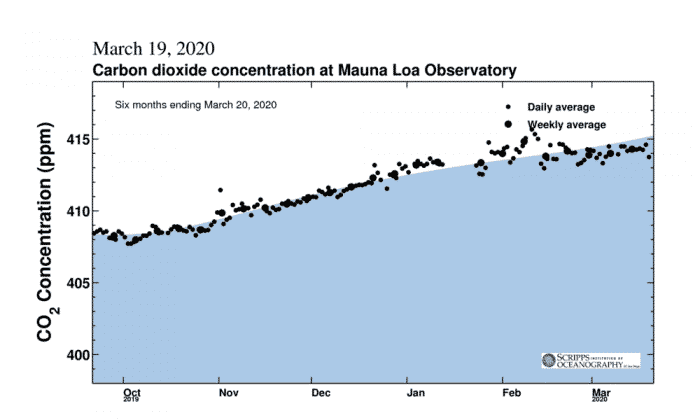Global CO2 levels continue to increase, despite the slowdown of the industry and traffic around the world due to the Covid-19. Compared to 2019, the CO2 levels have increased by at least 2-3 ppm (parts per million).Carbon dioxide (CO2) is a very well-known greenhouse gas, along with Methane (CH4), which is also a very potent greenhouse gas. Greenhouse gasses trap the heat from the Sun in the Earth's atmosphere, increasing global temperatures as the trapped heat cannot escape the atmosphere.
The graphics below from the NASA GEOS-5 analysis data shows the CO2 total column mass concentration around the world for July 25th. The Northern Hemisphere is currently experiencing reduced CO2 concentrations compared to the rest of the world, due to the natural seasonal consumption.
The high-resolution animation nicely shows how the CO2 actually circulates around the globe. It is not a single uniform layer across the entire world but usually varies greatly in concentration. That is why global averages are used for long term trends.
Global CO2 circulationIn 2020, the global CO2 levels have reached a record high in May, measuring around 414,5 parts per million (ppm). That means that per 1 million molecules of air, almost 415 of those were CO2 molecules. The previous highest number was in 2019 at around 411,9 ppm. The numbers are preliminary daily data averages from the NOAA dataset. Official refined data is yet to be released. Graphics below from NOAA/ESRL show the overall trend and values for the past years/decade.
One of the more used and well-known CO2 sampling sites is Mauna Loa, Hawaii. It has the longest record of direct measurements of CO
2 in the atmosphere. It is gathering data since May 1974, which makes this dataset a very good indicator of decadal CO2 trends. Data prior to 1974 is added from the observations of Scripps Institution of Oceanography.
Scientific studies and ice core data show that the last time the Earth experienced such a high level of carbon dioxide, was 3 to 5 million years ago. In that period, the temperature was 2-3C warmer and sea level was 10-20 meters higher than now. The image below shows the CO2 data for the past 800 000 years from Antarctic ice cores.
Global CO2 concentrations are being measured with satellites and by different stations around the world. Below we can see the data from different areas across the globe.
The seasonal cycle and a yearly increase is visible no matter where on the Earth we look.CO2 levels are increasing at a steady pace, but there is also a seasonal cycle. We know from the data that CO2 does not increase in a straight line with each and every day. Instead, we can actually see a seasonal decrease happen every year for a few months.
Below we have a graphic with data for the past year, where we can see the seasonal curve more closely. Why do the CO2 values drop every year and then rise again? The reason is quite simple. In late spring and summer, land and ocean vegetation (plant life) is abundant and consumes CO2 in the process of photosynthesis. In autumn and winter, the plants die off, and especially on land, the vegetation decays and releases some of the CO2 back into the atmosphere. Since most of the landmass and vegetation are in the Northern hemisphere, it has the strongest impact on the seasonal cycle.
Looking at the year-to-year increase, we can see that each year, global CO2 levels rise by more each year than a decade ago.
The trend shows that each decade the global CO2 levels will increase by more than the previous decade. The two graphics below show the comparison between the current 2020 period and the past two years. Despite some local differences due to weather patterns and tropical circulation, the overall base level CO2 is quite obviously higher in 2020 (positive values).
COVID-19 SLOWDOWNEarly in the year, the Covid-19 pandemic began to spread across the world. The global transportation has slowed as well as the industry. At the same time, data showed an interesting development. The CO2 levels were increasing at a much slower rate than expected. Looking at the 12 months of CO2 data from Mauna Loa observatory, we can see the CO2 rise last year and this season. It shows slower growth than expected, or when compared to the past years.


The problem is that global CO2 cannot be destroyed in a photochemical process, like ozone or methane. It follows its seasonal cycle, where it is consumed and then re-released back into the atmosphere. That is the usual seasonal cycle, which we explained earlier in the article.
If we add human emissions to the seasonal cycle, we get a non-natural faster increase in the base CO2 levels each year. So the CO2 cannot be destroyed, and we are just adding to its overall global supply. So even with a slowdown of industry and traffic during the Covid-19 pandemic, the emissions were not reduced for long enough and strong enough, to make an obvious impact or an actual reduction of the global CO2 levels. In a way, this was a test of the impact of reduced human emissions. It showed that heavy efforts and financial investments in renewable energy will be required to actively start to slow down the year-to-year CO2 growth trend, let alone reverse it.But where are the main emissions of CO2? We produced a map that shows the human sources of CO2 from fossil fuel burning, food production, industry, and transportation, from 2017 data. As expected, we see the Eurasian sector and North America as a major source of CO2 emissions. The industry and traffic in these areas were also heavily impacted by the Covid-19 pandemic. That is why a likely dip in global CO2 emissions was observed in February/March period, as the main contributors were affected by the Covid-19 lockdowns.
Comment: Better headline: 'Anthropogenic Global Warming Scam Debunked by COVID-19 Lockdown Scam'
See also: